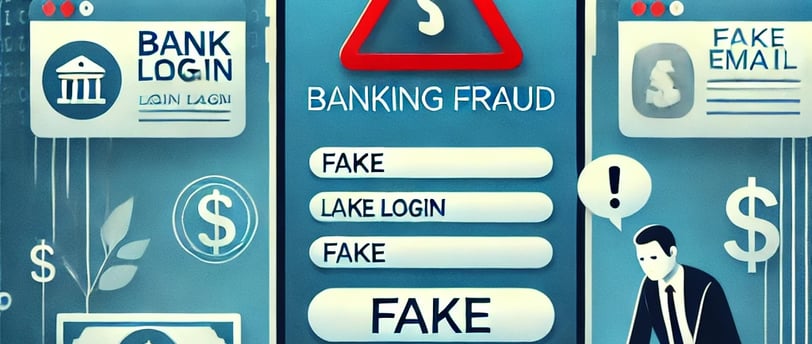Banking Scams
Learn how to identify messages or calls pretending to be from your bank and stealing your information.


How to Identify and Avoid Criminal Scams
Banking scams are among the most common frauds in Brazil, and with advancing technologies, criminals are constantly refining their techniques to deceive consumers and steal personal and financial data. These scams can occur through text messages, phone calls, emails, and even fake apps, often aiming to gain access to victims’ bank accounts.
In this article, we’ll explore in detail how banking scams work, the warning signs, and the best practices to protect your information and avoid falling into these traps.
How Do Banking Scams Work?
Criminals take advantage of victims' trust in financial institutions to carry out sophisticated scams. They simulate urgent situations, offering support or alerting about supposed account problems to prompt hasty actions.
Main Methods Used:
Phishing (Fake Emails or SMS): Messages impersonating the victim’s bank, containing links to fake pages designed to steal account numbers and passwords.
Fake Phone Calls: The scammer pretends to be a bank employee and claims the victim's account has been compromised, requesting personal data or authentication codes.
Fake Apps: Criminals create apps that mimic official bank apps, tricking users into providing their credentials.
WhatsApp and Social Media: The scammer contacts the victim pretending to be from a bank, requesting transfers or data for supposed account adjustments.
Malicious Links: Links sent via email or messages lead to fraudulent pages that capture sensitive information.
Warning Signs for Banking Scams
Although criminals' techniques are becoming more sophisticated, there are signs that can help identify banking scams. Stay alert to these characteristics:
1. Request for Sensitive Data
Banks never ask for passwords, authentication codes, or credit card details via phone, email, or text messages.
2. Urgent or Threatening Tone
Messages claiming that your account will be blocked or that there is fraud suspicion are often scams designed to force quick decisions.
3. Unsafe Emails or Links
Email addresses with spelling errors or links without HTTPS are clear signs of fraud.
4. Unsolicited Phone Calls
Be wary of calls offering help to resolve banking issues you didn’t report.
5. Unrealistic Promises
Offers of prizes, easy money, or significant discounts are commonly used as bait for scams.
How to Identify Fake Messages?
Banking scams via SMS, WhatsApp, or email are extremely common. Here are specific tips to identify these frauds:
1. Check the Sender
Verify that the phone number or email address belongs to the bank.
Messages from unknown numbers or generic senders (like "Bank Support") are suspicious.
2. Analyze the Content
Messages with grammatical or formatting errors are often fraudulent.
Be wary of messages urging immediate action, such as clicking a link or providing data.
3. Avoid Clicking on Suspicious Links
Hover over the link to check its destination before clicking.
Prefer accessing the bank’s website by typing the address directly into your browser.
4. Don’t Download Attachments
Attachments in banking emails may contain viruses or malicious software.
How to Identify Fake Phone Calls?
Fraudulent phone calls often use psychological manipulation tactics to deceive victims. Here are the warning signs:
1. Request for Data or Passwords
Banks never ask for passwords, card numbers, or authentication codes over the phone.
2. Offers of Unsolicited Help
Scammers often claim they’re helping protect your account from fraud, but they are the ones committing the scam.
3. Pressure to Make Immediate Decisions
If the caller pressures you to act quickly, be suspicious. Call the bank to verify the legitimacy of the call.
If using the same device, ensure you end the suspicious call before dialing the official number.
4. Unknown Caller Number
Always check the source number, and if possible, return the call to the bank’s official number.
How to Protect Yourself from Banking Scams
Protecting yourself from banking scams requires vigilance and good practices. Here are practical measures you can take:
1. Enable Two-Step Authentication
Activate additional authentication for your bank accounts to increase security.
2. Use Official Apps
Download the bank’s app only from official stores, such as the App Store or Google Play.
3. Never Share Passwords
Keep your passwords secure and avoid sharing them with others.
4. Regularly Update Your Data
Ensure your bank records are up to date to receive important alerts and notifications.
5. Avoid Public Wi-Fi Networks
Do not access banking apps or conduct transactions on public Wi-Fi networks, as they can be intercepted.
6. Use Security Software
Keep antivirus software updated on your devices to protect against malware and phishing attempts.
What to Do If You Suspect a Scam?
If you receive a suspicious message or call, follow these steps:
1. Do Not Share Data
Never provide personal or banking information.
2. Contact the Bank
Use official channels to confirm the legitimacy of the contact.
3. Report the Scam
Inform the bank about the scam so they can warn other customers.
4. Monitor Your Account
Regularly check your transactions and report any suspicious activity.
Conclusion
Banking scams are a constant threat, but with the right information and security practices, you can protect yourself and avoid losses. Remember that banks never request confidential information through unofficial channels and that any situation requiring immediate action should be approached cautiously.
By staying vigilant, you significantly reduce your chances of falling victim to these scams. Share this knowledge with friends and family, as awareness is the best weapon against criminals.
Protecting your financial information is essential for your security and peace of mind. Breathe, think, and always make informed decisions!
Security
Protect your family from online scams daily.
© 2024. All rights reserved.
